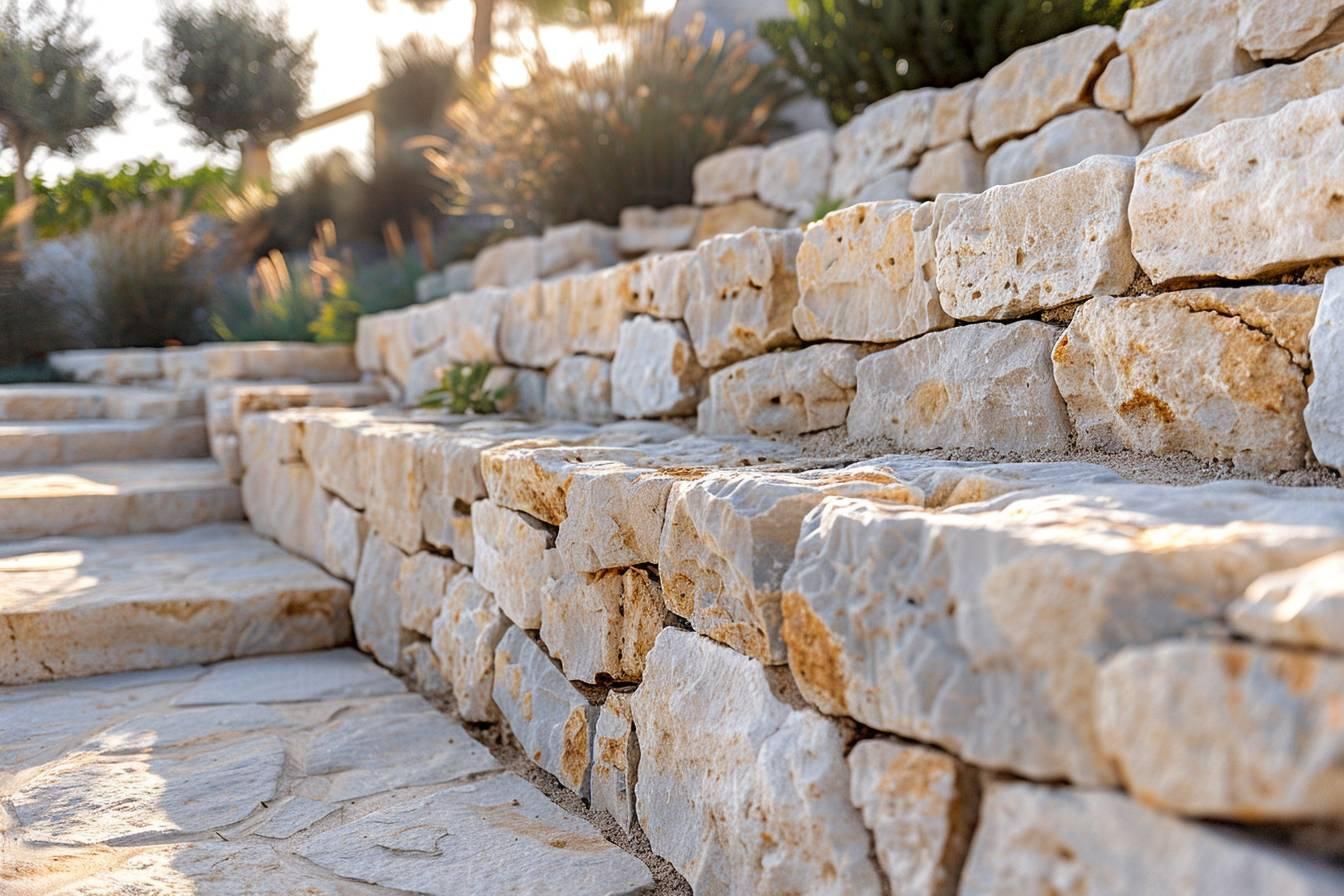Stone, an emblematic material for architecture and decoration, has stood the test of time with timeless elegance. Used for millennia, it continues to fascinate with its robustness and natural beauty. From Egyptian pyramids to modern skyscrapers, stone remains a key element in construction and interior design. Let’s explore the many facets of this noble material, its different types and its varied applications in our everyday environment.
Types of stone and their characteristics
The diversity of stone types opens up a wide range of possibilities for builders and decorators. Each type of stone has unique properties that determine its optimum use. Here’s an overview of the main categories of natural stone:
Granite, the igneous rock par excellence, stands out for its exceptional hardness and weather resistance. Its mottled appearance, the result of slow magma crystallization, makes it a popular choice for kitchen worktops and exterior cladding. Brittany granite, in particular, enjoys a worldwide reputation for quality.
Marble, a metamorphic stone synonymous with luxury, captivates with its elegant veins and polished surface. Used since Antiquity for sculptures and prestigious buildings, today it adorns refined interiors. Carrara marble, quarried in Italy’s Apuan Alps, remains a benchmark of excellence.
The limestone, formed by the accumulation of marine sediments, offers a palette of soft hues and a homogeneous texture. Its ease of cutting makes it a material of choice for sculpture and architectural ornamentation. Burgundy stone, a renowned limestone, adorns many of France’s historic monuments.
Slate, a layered metamorphic rock, is characterized by its dark color and ability to split into thin slabs. Traditionally used for roofing, it has also found a place in modern interior design. The slate quarries of Angers have long supplied this emblematic material.
Here’s a summary of the main characteristics of these stones:
| Type of stone | Hardness (Mohs scale) | Main uses | Geological origin |
|---|---|---|---|
| Granite | 6-7 | Worktops, exterior cladding | Igneous |
| Marble | 3-4 | Floors, sculptures, interior decoration | Metamorphic |
| Limestone | 3-4 | Construction, sculpture | Sedimentary |
| Slate | 3-4 | Roofing, wall cladding | Metamorphic |
Stone uses in construction
Natural stone remains a preferred building material, combining durability and aesthetics. Its use in building extends far beyond simple load-bearing walls. Let’s take a look at the most common applications of this age-old material in the construction of our living and working spaces.
Stone walls are the most obvious and oldest use. Whether they’re made of stone rubble assembled with mortar, or of carefully-fitted ashlar, these walls offer natural thermal insulation and remarkable resistance to the elements. The dry-stone technique, listed as a UNESCO intangible cultural heritage site, bears witness to the ancestral know-how associated with this material.
Stone foundations guarantee the stability of buildings. Their ability to distribute loads and resist moisture makes them a wise choice for durable construction. The builders of Gothic cathedrals such as Notre-Dame de Paris exploited these properties to erect structures that defied the test of time.
Natural stone paving and flagstones add character and robustness to outdoor spaces. From historic squares to contemporary terraces, stone offers a variety of finishes to suit every environment. The granite pavé de Paris is a perfect example of the longevity of this type of design.
In modern construction, stone finds its place as :
- Facade cladding, combining protection and aesthetics
- Structural elements, such as lintels and columns
- Staircases, combining safety and elegance
- Fireplaces, exploiting the thermal properties of stone
Architect Frank Lloyd Wright, a pioneer of organic architecture, often incorporated local stone into his designs, as in his famous Fallingwater house, underlining the link between buildings and their natural environment.

Stone in interior design
Beyond its structural role, stone is also a decorative element of choice in interior design. Its presence brings a touch of nobility and naturalness to spaces, creating an atmosphere that’s both warm and sophisticated. Let’s find out how this ancient material fits into contemporary interiors.
Stone wall coverings radically transform the ambience of a room. Whether it’s schist cladding for a rustic effect or polished marble for a luxurious finish, these claddings add texture and character. Burgundy stone, with its soft nuances, blends perfectly with both modern and classic decors.
Natural stone worktops combine functionality and aesthetics in kitchens and bathrooms. Scratch- and heat-resistant granite is a practical and durable choice. Marble, despite its sensitivity to acids, remains popular for its timeless elegance.
Decorative stone elements punctuate the space with refinement:
- Stone mantels, convivial fireplaces
- Sculptures and bas-reliefs, adding an artistic dimension
- Carved basins and sinks, combining beauty and practicality
- Columns and pilasters, visually structuring volumes
The integration of stone into contemporary furnishings testifies to its versatility. Marble coffee tables, travertine consoles and slate shelves combine the naturalness of stone with clean lines. Designer Eero Saarinen, with his famous Tulipe table, masterfully combined marble with modernist forms.
Mosaics, an age-old art form, are enjoying a renaissance in interior design. Using tesserae of natural stone, it creates unique patterns, from the simplest to the most complex. The mosaics of Ravenna in Italy, jewels of Byzantine art, still inspire contemporary designers today.
Last but not least, decorative stone objects such as vases, candleholders and bookends add a subtle mineral touch to the decor. These natural accents harmoniously counterbalance the synthetic materials so ubiquitous in our modern interiors.
Future prospects for the use of stone
The use of stone in construction and decoration continues to evolve, adapting to contemporary challenges and technological innovations. This raw material, which has been used for thousands of years, is reinventing itself to meet the demands of the 21st century in terms of durability, aesthetics and performance.
Eco-construction is rediscovering the virtues of stone. Its exceptional durability and low environmental impact make it the material of choice for buildings with a low carbon footprint. Ancestral techniques, such as dry-stone construction, are enjoying a revival for their simplicity and respect for the environment.
New cutting and shaping technologies are opening up unprecedented prospects. Water-jet cutting and numerical control enable the creation of complex shapes and innovative designs, widening the field of possibilities for architects and designers. Architect Zaha Hadid has exploited these advances to create organic stone structures that defy the laws of gravity.
Composite stone, a blend of natural stone and resins, offers an interesting alternative. Lighter and easier to work than solid stone, it retains the aesthetic appeal of the natural material while improving certain mechanical properties.
Integrating technologies into stone opens up new horizons:
- Photoluminescent stones for passive lighting
- Stone surfaces integrating sensors for home automation
- Self-cleaning stone coatings thanks to nanotechnological treatments
Reusing and recycling stone is part of a circular economy approach. Stone from demolition sites finds a second life in new buildings, or is transformed into aggregates for other applications.
Finally, research into the thermal properties of stone could revolutionize its use in sustainable construction. Exploiting its ability to store heat could contribute to the energy efficiency of buildings, thereby reducing their consumption.
Stone, an age-old material, demonstrates its ability to adapt to the challenges of the future. Between tradition and innovation, it continues to shape our built environment, combining timeless beauty with modern performance. Its future looks as solid as its very nature, promising exciting new applications in the world of construction and decoration.

